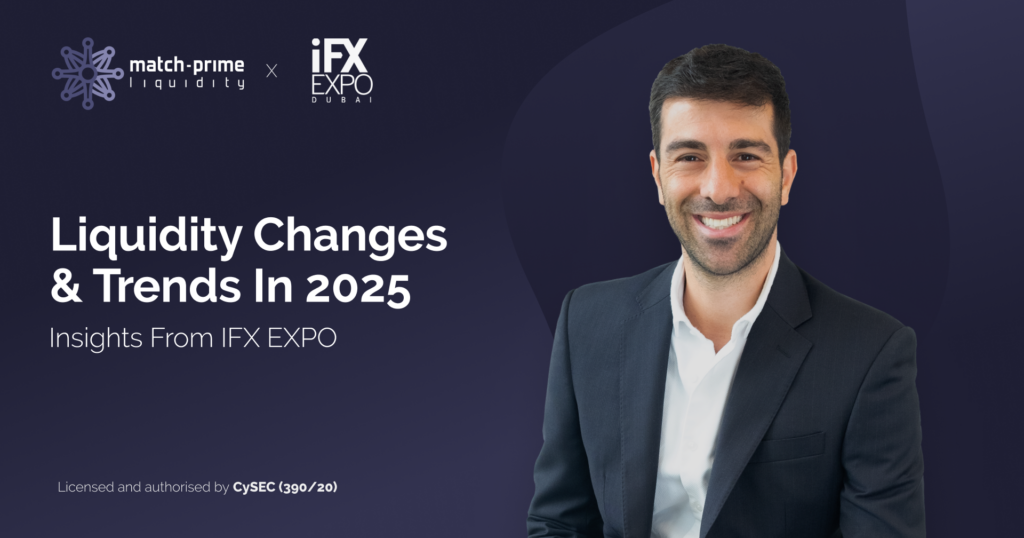The future of liquidity took centre stage at Dubai’s iFX EXPO, where industry leaders gathered to break down what’s happening in the trading landscape. The panel explored how regulations, technological advancements and geopolitical factors have reshaped liquidity provision in recent years. This overview captures expert insights on the market’s structural changes, gold liquidity challenges, AI’s growing influence and strategic approaches for liquidity providers navigating 2025.

Liquidity Changes in the Last Few Years
The financial world has undergone considerable transformation since the 2008 Global Financial Crisis. “Every year, new things have come into play. I would say that regulations, for sure, are something that we had to engage with and embrace. And obviously, they’ve affected us”, says Andreas Kapsos, CEO at Match-Prime Liquidity. Regulatory frameworks like Dodd-Frank, MiFID II, Basel III and the forthcoming Basel IV have substantially increased capital requirements, making risk-holding much more expensive for traditional banking institutions and forcing them to change their trading models. This evolution has shifted market structure, leading to diminished bank liquidity balanced by the rapid rise of non-bank LPs, who now constitute over 50% of Forex market liquidity.
Technology has been instrumental in this transition, enabling smart order routing and low-latency infrastructure that have opened market access beyond just banks and large corporations to include retail traders, prop trading firms and smaller players. The market structure has consequently become more fragmented across multiple venues, especially after the black swan event that made banks add risk premium elements to their pricing, further accelerating non-bank participation.
The result is a market with tighter spreads, larger execution sizes, much faster execution times and more endpoints, with liquidity providers now simultaneously pricing to millions of clients rather than limiting distribution to select ECNs or brokers.
Causes of Liquidity Problems in Gold Markets
Gold markets continue to face serious liquidity challenges despite the metal’s reputation as a safe-haven investment. A persistent gap between physical gold markets and futures prices has led to disruptions, as seen during both the COVID pandemic and December 24 events when we saw severe market dislocation and wider spreads. This instability comes from complex rehypothecation practices where multiple financial claims exist for the same physical gold through unclear lending chains.
When demand for physical gold suddenly spikes, these interconnected lending structures can cause rapid liquidity crunches as claims are called in simultaneously. Potential solutions include more transparent lending frameworks, improved risk management based on volatility rather than market conditions and proactive communication between liquidity providers and clients. Some market participants are already implementing alternative pricing methodologies that don’t automatically widen spreads during market stress. Also, the emergence of new regional gold hubs like the UAE may help diversify market infrastructure, but without major cross-border regulatory reforms addressing these structural weaknesses, gold markets will likely continue experiencing periodic liquidity squeezes.
How AI Is Transforming Liquidity
The tech revolution in financial markets has been transformative, requiring significant attention and investment from all market participants. We’re witnessing an unprecedented rise in high-frequency trading and AI-powered algorithms from the client side, creating increasingly challenging flow patterns for price makers to handle.
At the same time, liquidity providers are deploying these same advanced technologies to improve price discovery and market predictions, which has led to tangible benefits such as tighter spreads. This technological race requires substantial capital investment in hardware, connectivity infrastructure, staff and risk management systems.
Beyond pricing efficiency, machine learning models are revolutionising how liquidity is customised by matching specific client trading patterns, order sizes and frequencies with the right price streams—essentially connecting the right liquidity to the right clientele. As AI becomes more integrated into both client strategies and liquidity providers’ operations, we’re seeing a relationship where better price discovery and market prediction capabilities benefit the entire ecosystem, from regular clients to corporate entities.
The market’s technological evolution has progressed from high-frequency trading and co-location to smart order routing, then to execution algorithms, and now to predictive and adaptive AI. This progression has fundamentally altered behavioural expectations, with even average traders now demanding institutional-grade pricing, fast execution and perfect order routing with no slippage—creating both challenges and opportunities for forward-thinking brokers and market participants.
Strategies for LPs in 2025
Maintaining a robust risk management approach is crucial in today’s volatile markets. Liquidity providers must also focus on delivering sustainable products with genuine utility instead of artificially engineered price constructs. The cornerstone of effective liquidity provision lies in open communication between banks and liquidity providers—the more they understand the client profiles and trade tagging, the more precisely they can adjust pricing models.
Looking at pivotal market changes in recent years, it is essential to adopt a practical approach and recognise how international connections shape the trading environment. “With recent geopolitical events and everything that has been happening, we need to keep up with them,” Andreas Kapsos points out. The key to success lies in responding well to what clients need while dealing with the changing geopolitical factors that constantly reshape market conditions and risk measurements.
While AI is a powerful analytical tool when trained properly, LPs should remain cautious. Simply adding it to their trading strategies doesn’t guarantee exceptional performance—its effective use requires substantial investment and expertise.
Want to hear more from top liquidity experts? Watch the full panel session.

